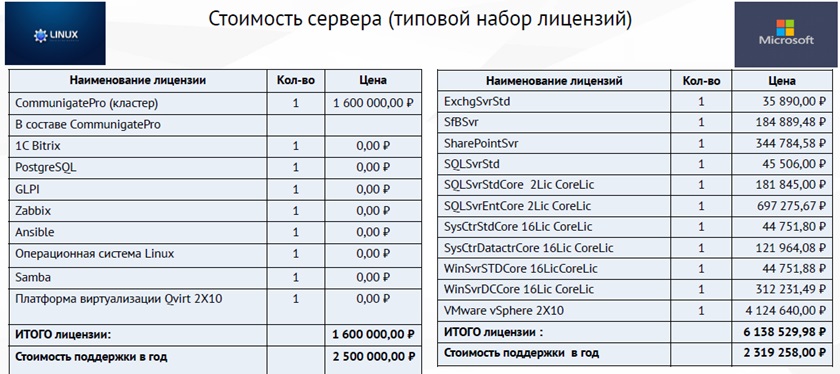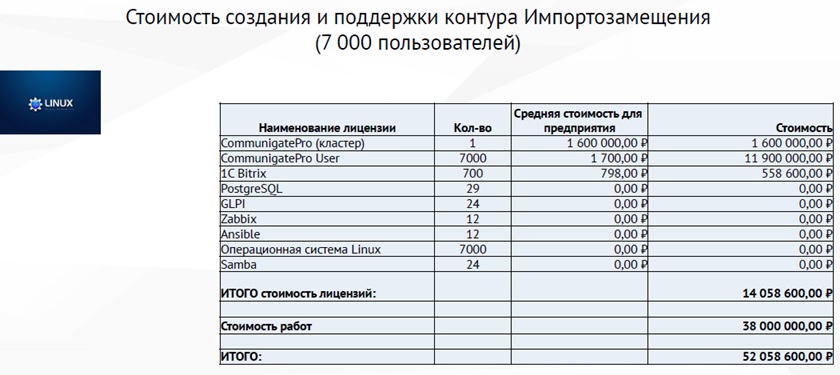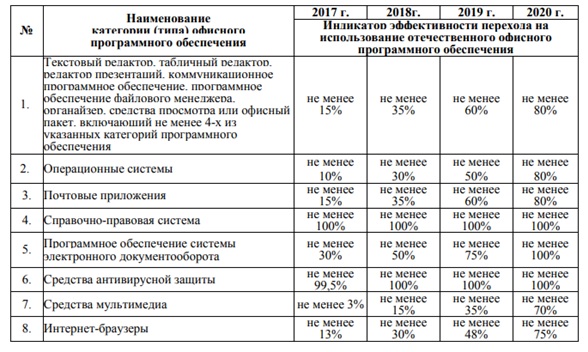Import substitution, or how Russian Helicopters did something wrong
Due to the fact that 2020 is approaching and the “hour of he”, when it will be necessary to report on the execution of the Ministry of Communications order to switch to domestic software (within the framework of import substitution), I received the task of developing a plan, in fact, following the order of the Ministry of Communications and mass communications №334 from 06/29/2017. And I began to understand. And the first thing I stumbled upon was an article that Russian Helicopters had already done everything and that they should learn from their experience. Is everything so smooth? .. Let's take a look.
Not so long ago, Mikhail Nosov, CIO of the Russian Helicopters holding, told about how they carried out the order of the Ministry of Communications on import substitution of software. Showed a presentation with numbers and benefits from switching to domestic software ... And everything would be fine, but there are a lot of inconsistencies there ...
So, in order.
To begin with - the registry of the Ministry of Communications.
')
This article is about the same on a bunch of sites, here is an example. It says "how to" switch to domestic software and all that ... But. Here is one of the first pictures, which shows a set of software and its cost per job:

And here I have a couple of questions:
About SAMBA , Zabbix and others will be lower, do not worry.
Go ahead.
Picture "Import Substitution Server Segment":

What do we see here? Well, at least Q.Virt , which? .. That's right, is also not included in the register of the Ministry of Communications, and therefore also does not fit. There are several virtualization software in the registry, the prices are:
ROSA Virtualization 50 virtual machines cost 470,000 rubles, the extension of support for the year - 360,000 rubles.
ISPSystem VMmanager 1 node 7 239 rub. Accordingly, 50 knots - 361 950 rubles.
“BREST” VIRTUALIZATION SOFTWARE COMPLEX (based on AstraLinux) is difficult in principle to understand what they offer, but apparently it is a hardware platform with the possibility of virtualization and remote desktops, a mail server (some), a DBMS (some This) and another set of software. RDP for 25 users costs 401,280 rubles. Basic version of the license, for small virtual infrastructures, for 3 servers (whatever that means ) - 150,000 rubles.
The remaining virtualization tools are not available for free sale, which means that there will be different prices for each Enterprise, and this is no longer a business, so there’s no point in looking at them.
And then in order:
Astra Linux-based DNS server is nothing more than BIND9 . And it is not in the register of the Ministry of Communications. There is only DNSmanager , and it is paid from 50 domain names. You can use something else that is different from BIND9, but this will not be in the registry of the Ministry of Communications too ... That is, the slip came out again.
There is no DHCP server in the registry at all. My research in the direction of software import substitution led to the fact that DHCP (and DNS) can be legally raised only on the basis of ROSA Linux , they have their own DHCP server, but I have not yet understood on the basis of what it was made ...
AD they replaced with SAMBA ... And again the same thing, it is not in the registry. ROSA has its own authorization server, but I haven’t yet understood what is under the hood.
Zabbix - there too. Although it was developed by our compatriot, it is not Russian software.
GLPI - there too.
Bacula - again there ...
Ansible - well, you understand ...
BUT. There is one big, fatty such BUT . There is unofficial information that everything that is included in the OS delivery package is legitimate from the point of view of import substitution. Officially, I did not find this information. And this calls into question the whole idea of import substitution in its current state. Because all these packages are not domestic, but, as far as can be judged, they were checked and certified, that is, they were approved, and they were included in the OS in the registry of the Ministry of Communications and Mass Communications ... But if you put them separately from the repositories - already nyzayayaya ... I xs, what here is the logic and how it works ...
Still there is a picture with the cost of a “typical server”:

That is, on a typical server they had this all here. On each server. VMware vSphere. On each. Not free Microsoft Hyper-V Core on virtualization cluster hosts, but on every server on VMware vSphere. And more on SQL Server on each. And SharePoint is still on top!I just see how they admins there are covered with licenses of SharePoint and MSSQLServer! Sorry, could not resist.
There is also a sign with the number of users (approximate, of course, but still indicative):

7,000 users! And only 52 million rubles for the support! True, this is without taking into account the virtualization hosts, OS support for 7000 copies, extension of support for the office suite ...
At the end I will cite the “ Recommended form of the schedule of transition of enterprises, institutions, organizations subordinated to the state body to the use of domestic office software, as well as the recommended indicators of the effectiveness of the transition to the use of domestic office software for the period 2017–2020 ”:

It does not say about 100% import substitution, which gives enough freedom for the flight of thought.
What conclusions can be drawn from all this? First, it’s not necessary to have a temper rush from the very first days after the bills are issued, to fulfill these same bills, they still have time to change ten times. The second is to carefully read these bills so that employees do not have to retrain three times from one office suite to another ...
Later, when I finish developing a plan for import substitution, I’ll definitely share that there is no “anyone can criticize, and you can take it and do it!”
An article about import substitution planning.
Article about the choice of domestic hypervisor.
The prices for software quoted in the article are taken from the SoftLine website.
Not so long ago, Mikhail Nosov, CIO of the Russian Helicopters holding, told about how they carried out the order of the Ministry of Communications on import substitution of software. Showed a presentation with numbers and benefits from switching to domestic software ... And everything would be fine, but there are a lot of inconsistencies there ...
So, in order.
To begin with - the registry of the Ministry of Communications.
')
This article is about the same on a bunch of sites, here is an example. It says "how to" switch to domestic software and all that ... But. Here is one of the first pictures, which shows a set of software and its cost per job:

And here I have a couple of questions:
- The cost of a license OS Linux. The fact is that “Helicopters of Russia” is a military organization, the requirements are tough for them, they cannot take and deliver untested software, only certified by FSTEC or the Ministry of Defense. And the price of one such license for the same Astra Linux Special Edition , which, in fact, was implemented in “Helicopters”, currently amounts to 14,900 rubles. a piece. And on the slide we see 0 rubles.
- What is Kaspersky for Linux for ? On Windows it was not ..
About SAMBA , Zabbix and others will be lower, do not worry.
Go ahead.
Picture "Import Substitution Server Segment":

What do we see here? Well, at least Q.Virt , which? .. That's right, is also not included in the register of the Ministry of Communications, and therefore also does not fit. There are several virtualization software in the registry, the prices are:
ROSA Virtualization 50 virtual machines cost 470,000 rubles, the extension of support for the year - 360,000 rubles.
ISPSystem VMmanager 1 node 7 239 rub. Accordingly, 50 knots - 361 950 rubles.
“BREST” VIRTUALIZATION SOFTWARE COMPLEX (based on AstraLinux) is difficult in principle to understand what they offer, but apparently it is a hardware platform with the possibility of virtualization and remote desktops, a mail server (some), a DBMS (some This) and another set of software. RDP for 25 users costs 401,280 rubles. Basic version of the license, for small virtual infrastructures, for 3 servers (
The remaining virtualization tools are not available for free sale, which means that there will be different prices for each Enterprise, and this is no longer a business, so there’s no point in looking at them.
And then in order:
Astra Linux-based DNS server is nothing more than BIND9 . And it is not in the register of the Ministry of Communications. There is only DNSmanager , and it is paid from 50 domain names. You can use something else that is different from BIND9, but this will not be in the registry of the Ministry of Communications too ... That is, the slip came out again.
There is no DHCP server in the registry at all. My research in the direction of software import substitution led to the fact that DHCP (and DNS) can be legally raised only on the basis of ROSA Linux , they have their own DHCP server, but I have not yet understood on the basis of what it was made ...
AD they replaced with SAMBA ... And again the same thing, it is not in the registry. ROSA has its own authorization server, but I haven’t yet understood what is under the hood.
Zabbix - there too. Although it was developed by our compatriot, it is not Russian software.
GLPI - there too.
Bacula - again there ...
Ansible - well, you understand ...
BUT. There is one big, fatty such BUT . There is unofficial information that everything that is included in the OS delivery package is legitimate from the point of view of import substitution. Officially, I did not find this information. And this calls into question the whole idea of import substitution in its current state. Because all these packages are not domestic, but, as far as can be judged, they were checked and certified, that is, they were approved, and they were included in the OS in the registry of the Ministry of Communications and Mass Communications ... But if you put them separately from the repositories - already nyzayayaya ... I xs, what here is the logic and how it works ...
Still there is a picture with the cost of a “typical server”:

That is, on a typical server they had this all here. On each server. VMware vSphere. On each. Not free Microsoft Hyper-V Core on virtualization cluster hosts, but on every server on VMware vSphere. And more on SQL Server on each. And SharePoint is still on top!
There is also a sign with the number of users (approximate, of course, but still indicative):

7,000 users! And only 52 million rubles for the support! True, this is without taking into account the virtualization hosts, OS support for 7000 copies, extension of support for the office suite ...
At the end I will cite the “ Recommended form of the schedule of transition of enterprises, institutions, organizations subordinated to the state body to the use of domestic office software, as well as the recommended indicators of the effectiveness of the transition to the use of domestic office software for the period 2017–2020 ”:

It does not say about 100% import substitution, which gives enough freedom for the flight of thought.
What conclusions can be drawn from all this? First, it’s not necessary to have a temper rush from the very first days after the bills are issued, to fulfill these same bills, they still have time to change ten times. The second is to carefully read these bills so that employees do not have to retrain three times from one office suite to another ...
An article about import substitution planning.
Article about the choice of domestic hypervisor.
The prices for software quoted in the article are taken from the SoftLine website.
Source: https://habr.com/ru/post/446576/
All Articles